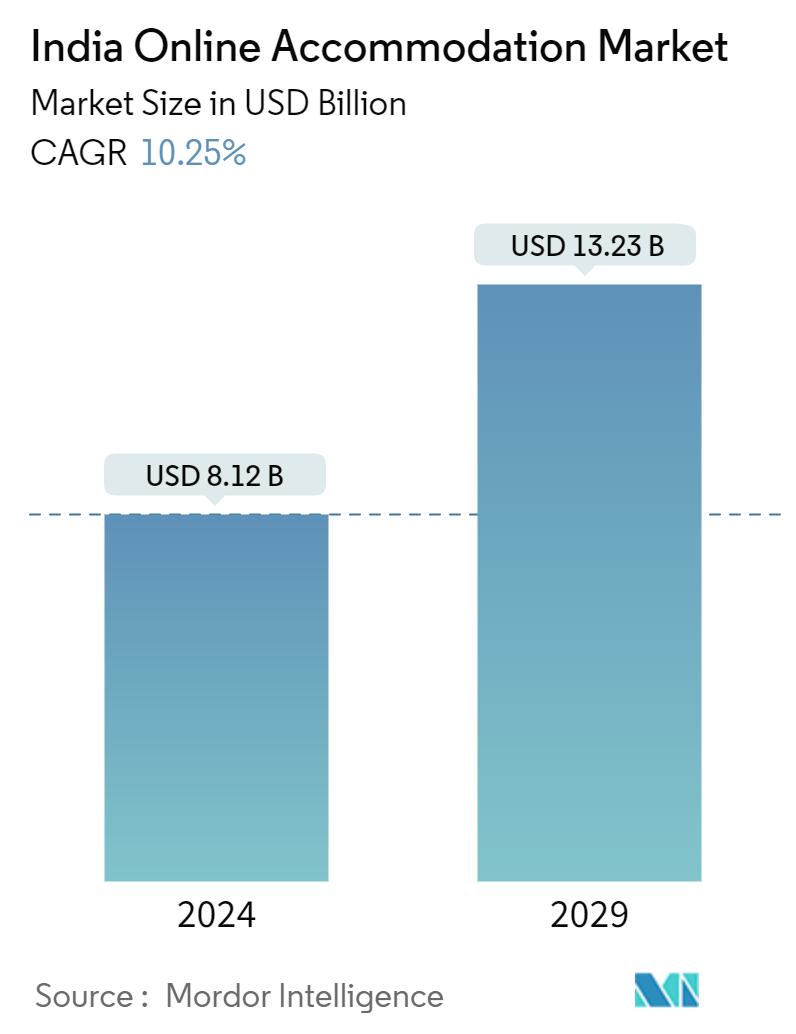Market Size of India Online Accommodation Industry

| Study Period | 2020- 2029 |
| Base Year For Estimation | 2023 |
| Market Size (2024) | USD 8.12 Billion |
| Market Size (2029) | USD 13.23 Billion |
| CAGR (2024 - 2029) | 10.25 % |
| Market Concentration | Low |
Major Players
*Disclaimer: Major Players sorted in no particular order |
India Online Accommodation Market Analysis
The India Online Accommodation Market size is estimated at USD 8.12 billion in 2024, and is expected to reach USD 13.23 billion by 2029, growing at a CAGR of 10.25% during the forecast period (2024-2029).
The online accommodation market in India has seen tremendous growth in the last decade. Several factors have contributed to the growth of the market, such as smartphone penetration, internet penetration, and a rise in the middle-class population. Online Travel Agency (OTA) and accommodation aggregators have played an important role in the development of the market by allowing accommodation providers to present their services and travelers to easily book their accommodation.
India offers a wide range of travel destinations due to its diverse culture from one region to another and its abundance of historical and religious sites. This makes India a large market for both international and domestic travelers. In recent years, the country has also become a popular destination for spiritual and yoga tourists around the world. This growth in tourism has also increased the demand for accommodation services in recent years.
With the help of technology and low internet prices, people can easily book hotels or houses online from the convenience of their homes and plan their trips. This has led to the growth of online accommodation services in India. Many players have stepped into the Indian online accommodation market to capitalize on this opportunity.
India Online Accommodation Industry Segmentation
Online booking of hotel rooms is popular, and travelers are able to make reservations by using online security in order to protect their privacy and financial information while comparing prices and facilities at different hotels through the use of several Internet travel agents.
The Indian online accommodation market is segmented by platform type and mode of booking type. By platform type, the market is segmented into mobile applications and websites. By mode of booking type, the market is segmented into third-party online portals and direct/captive portals. The report provides market size and forecasts for India's online accommodation market in value (USD) for all the above segments.
| By Platform | |
| Mobile Application | |
| Website |
| By Mode of Booking | |
| Third Party Online Portals | |
| Direct/Captive Portals |
India Online Accommodation Market Size Summary
The online accommodation market in India is experiencing significant expansion, driven by factors such as increased smartphone and internet penetration, and a growing middle-class population. The market's growth is further bolstered by the role of Online Travel Agencies (OTAs) and accommodation aggregators, which facilitate easy booking and service presentation for accommodation providers. India's diverse cultural landscape and abundance of historical and religious sites make it a prime destination for both domestic and international travelers, including those seeking spiritual and yoga experiences. The convenience of technology and affordable internet access has made online booking of hotels and homes more accessible, attracting numerous players to the market.
The shift towards cashless transactions, supported by the Indian government's policies and the rise of digital payment solutions like UPI, has also contributed to the market's growth. Airlines and travel brands are adapting to these changes by offering various electronic payment options, enhancing the booking experience for Indian consumers. The tourism sector, heavily influenced by the hotel industry and supported by government initiatives to promote tourism, has seen a surge in both domestic and foreign visitors. The online accommodation market in India is characterized by fragmentation, with key players such as MakeMyTrip, Booking.com, IRCTC, EaseMyTrip.com, and Goibibo leading the charge. These companies are continuously innovating and forming strategic partnerships to meet the evolving demands of customers, as evidenced by recent developments like EaseMyTrip's offline retail expansion and collaborations with tech giants like Microsoft.
India Online Accommodation Market Size - Table of Contents
-
1. MARKET DYNAMICS
-
1.1 Market Overview
-
1.2 Market Drivers
-
1.2.1 Rise in the Number of Travel Bloggers Is Promoting Tourism Driving the Market's Growth
-
1.2.2 Rising Number of Hotels, Resorts, and Airbnb Options for Consumers Driving the Market's Growth
-
-
1.3 Market Restraints
-
1.3.1 Difficulty in Handling Customer Queries and Cancellation Policies
-
1.3.2 High Convenience Fees Impacting the Market's Growth
-
-
1.4 Market Opportunities
-
1.4.1 Online Travel Booking Platforms Are Offering Complementary Services to Promote More Online Bookings
-
1.4.2 Customized and Personalized Holiday Packages Will Boost the Growth of the Market
-
-
1.5 Value Chain / Supply Chain Analysis
-
1.6 Industry Attractiveness - Porter's Five Force Analysis
-
1.6.1 Threat of New Entrants
-
1.6.2 Bargaining Power of Buyers/Consumers
-
1.6.3 Bargaining Power of Suppliers
-
1.6.4 Threat of Substitute Products
-
1.6.5 Intensity of Competitive Rivalry
-
-
1.7 Insights into Technological Advancements in the Industry
-
1.8 Impact of COVID-19 on the Market
-
-
2. MARKET SEGMENTATION
-
2.1 By Platform
-
2.1.1 Mobile Application
-
2.1.2 Website
-
-
2.2 By Mode of Booking
-
2.2.1 Third Party Online Portals
-
2.2.2 Direct/Captive Portals
-
-
India Online Accommodation Market Size FAQs
How big is the India Online Accommodation Market?
The India Online Accommodation Market size is expected to reach USD 8.12 billion in 2024 and grow at a CAGR of 10.25% to reach USD 13.23 billion by 2029.
What is the current India Online Accommodation Market size?
In 2024, the India Online Accommodation Market size is expected to reach USD 8.12 billion.

